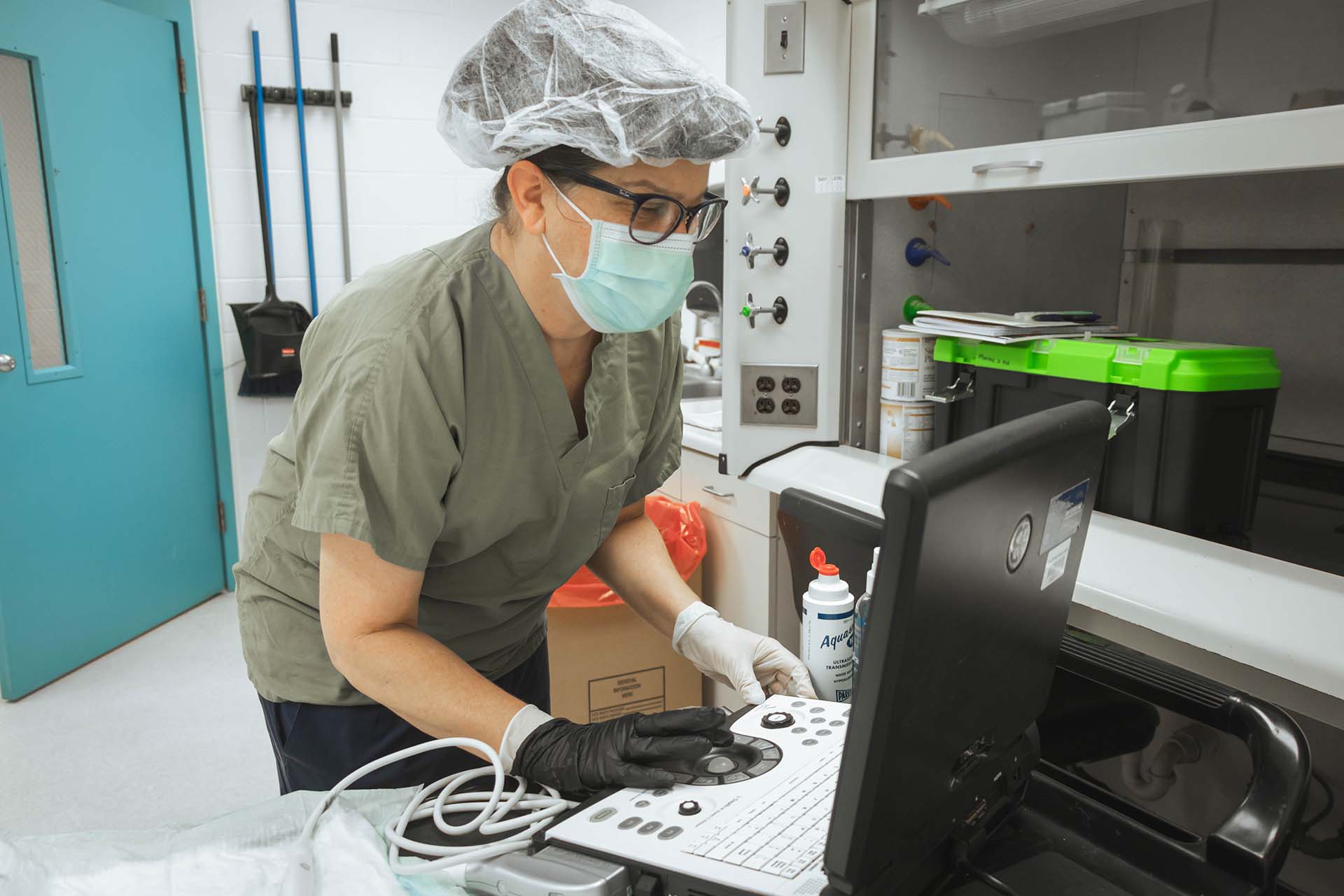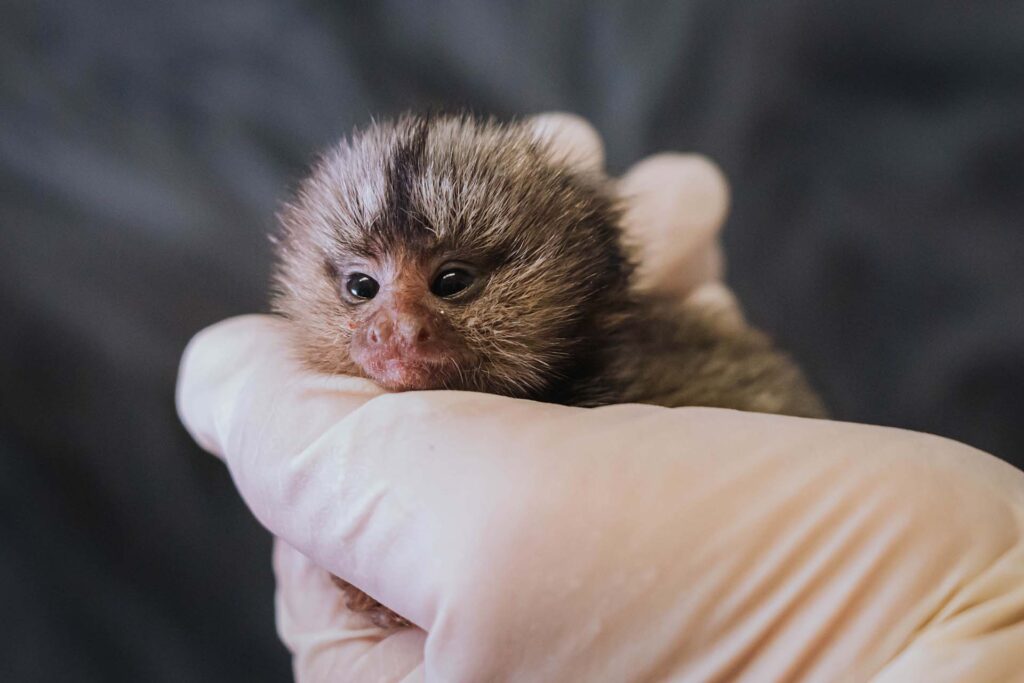Meet Donna Layne-Colon: Marmoset Colony Manager

Texas Biomed’s Southwest National Primate Research Center (SNPRC) houses more than 450 marmosets – the largest marmoset research colony in North America and second largest in the world.
Colony manager Donna Layne-Colon knows every single one. And, having been with the colony since its inception 30 years ago, she can tell you who each animal’s parents and grandparents were without a moment of hesitation.
“It’s astounding,” says Corinna Ross, PhD, SNPRC Director. “She has the entire marmoset pedigree database stored in her head.”
This is especially helpful because as colony manager, Layne-Colon decides which animals should be paired for breeding to maximize genetic diversity – not just at SNPRC, but also when collaborating with other institutes and their marmoset colonies.
“It also means when we have something show up clinically, she can track it back and say, ‘Oh, yeah, her sister had that or her great aunt to the second degree had that,’” Dr. Ross says.
Growing a healthy, robust colony is important because marmosets help researchers study a wide range of human and animal health conditions: reproduction and development, microbiomes and obesity, aging and neurological disorders. Common marmosets are much smaller and shorter-lived than other nonhuman primates; about the size of guinea pigs, but with long, fluffy tails. The lifespan of a marmoset receiving around-the-clock care, like at SNPRC, ranges from 12 to 19 years.
Suzette Tardif, PhD, Texas Biomed Professor Emeritus and retired SNPRC Associate Director, established the colony at The University of Tennessee in 1993. At that time, Layne-Colon was an undergraduate majoring in zoology and anthropology, and worked as a research assistant caring for a wide variety of lab animals.
“It didn’t matter to me what species, I started off working with reptiles, amphibians and fish,” she says. “The herpetology lab had a boa constrictor that took three people to carry through the halls to be weighed once a year.”
When the opportunity arose to care for the marmosets as well, Layne-Colon happily took on the additional job – a decision that would shape the rest of her career.
“It will be 30 years this November,” she says. “Each time she moved, Suzette asked if I wanted to go with her. I said ‘yeah, of course.’”
Dr. Tardif, Layne-Colon and the marmosets moved from Tennessee to Kent State in Ohio in 1995 and then to Texas Biomed in 2001. Over the years, the colony has grown from 45 to more than 450 through breeding and adding animals from other universities.
In the 2000s, Dr. Tardif, Dr. Ross and Layne-Colon led the efforts to establish marmosets as a research model for aging, documenting how they naturally develop most, though not all, of the same conditions and diseases as humans do in later years. The monkeys are also unique because they give birth to twins and triplets, providing a strong foundation for studying the interplay between genetics, environment, development and diseases. The marmosets have also been vital in learning more about how Zika virus passes from mother to fetus and test promising vaccine candidates.
Layne-Colon has been there for all of it, working alongside caretakers, veterinarians and researchers. She especially enjoys conducting ultrasounds to monitor mothers and offspring throughout pregnancies.
“I have seen them from in utero all the way through,” she says. “I’ve watched a lot of births, taken care of a lot of babies.”
Often, she stays overnight to observe the births, collect samples for tissue databases and document animal behavior. She prefers knowing exactly what happened versus coming in the next morning and having to guess. While she is well past the stage of providing basic care, such as daily feeding and cleaning, she is still always happy to help on the weekends when needed.
“She is the ultimate caretaker,” Dr. Ross says.

Donna Layne-Colon regularly
conducts ultrasounds to monitor
mother and offspring health.
Layne-Colon’s love of animals began as a young girl growing up on a farm in Appomattox, Virginia.
“All of the kids, we kept turtles, lizards, snakes, baby bunnies, raised baby birds, raised baby deer, turkeys, you know, that sort of thing,” Layne-Colon says. “We had a few cows, but our friends ran a full dairy, so when we went to sleepovers with our friends, we were in the milk house at four in the morning.”
When she began caring for marmosets, there was no manual or how-to guide.
“There still isn’t,” she says.
“The Common Marmoset in Captivity and Biomedical Research” – or “blue book” as it is known – is as close as the field gets. The two-inch-thick text was the first to summarize knowledge about the species. It was edited by Dr. Tardif; Layne-Colon wrote chapters on housing and husbandry; co-authors also include Dr. Ross and SNPRC veterinarian Anna Goodroe, DVM.
While Dr. Tardif is recognized as the pioneer of marmoset research in the U.S., and passed the leadership baton on to Dr. Ross, Layne-Colon is well-regarded as the go-to resource for all things marmosets. She receives calls and emails weekly from all over the world seeking advice on everything from medical care and breeding, to housing and research protocols.
“When I was a graduate student, long before I came to Texas Biomed, I was told to call Donna,” Dr. Ross says. “Though technically now I am her boss, she has been my mentor for more than 20 years.”
Layne-Colon is keen to share her knowledge so misconceptions can be dispelled and species- appropriate care can be given.

“Marmosets are not just little macaques,” she says, referring to another primate species used in biomedical research and at SNPRC.
Her office door, desk and walls are adorned with marmoset memorabilia, alongside art of other species she has worked with and anime drawings by her 14-year-old son. She is passionate about preserving the history of both the animals and the people working with them.
“I keep a ton of history about marmosets all over the country and the world. To me, it’s interesting,” she says. “A lot of the folks that remember the early years, they’re in the retirement group now, so that stuff will be lost.”
Dr. Tardif underscored how Layne-Colon is not one to sing her own praises, despite making such significant contributions to the field.
“She was an absolutely critical eye to me in terms of thinking about how to move research forward,” Dr. Tardif says. “She would always say, very politely, ‘Well, that’s an interesting idea, but here’s the thing, you know, I don’t think a marmoset would actually do that.’”
It’s all part of “what makes Donna, Donna,” colleagues say. Not just a compassionate and intelligent scientist with an incredible memory, but a one-of-a-kind individual.
“Donna is a what I would call a true naturalist,” says Dr. Tardif. “She gets animals in a way that’s both scientific but also real visceral. She has the capacity to get inside the animal, really understanding the animals’ perspective. That can be learned, but it is also – I think – a gift.”